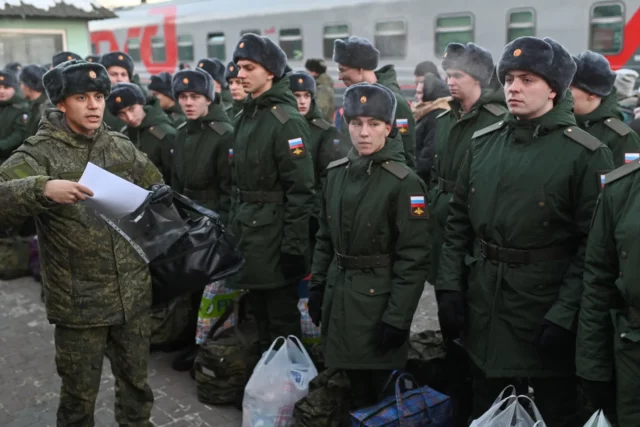
New Draft and Mobilization Rules in Russia: Increased Coercion
Publication: Eurasia Daily Monitor Volume: 20 Issue: 121
By:

On July 25, the Russian State Duma finally passed two laws that increase the age range for draft-eligible Russian men from 18–26 years old to 18–29 years old and that significantly increase the fines for avoiding recruitment and other violations during conscription and mobilization campaigns. These efforts can be considered as definitive confirmation of significant failures during the conscription campaigns of 2022 and 2023 as well as during the “partial mobilization” carried out in fall of last year. The Kremlin is trying to fix major problems with Russian citizens’ reluctance to serve in the war against Ukraine and to make further progress in finding a lasting solution to the severe deficit in combat manpower. Additionally, Russian officials are hoping to expand their domestic room for maneuver, as the combat situation in Ukraine continues to worsen (Sozd.duma.gov.ru, July 25; Sozd.duma.gov.ru, July 25).
The draft version of the first law originally proposed to increase the draft age range to 21–29 years old with an option to recruit those who desire to serve as early as age 18 (see EDM, March 20). The main reason for this suggestion was to improve enforcement of service in the Russian Armed Forces as early as possible, instead of dealing with longer periods and increased numbers of draft evasions. That is why those Russian men who are age 27 or older in 2023 are not covered by the law. Briefly speaking, there is actually not much difference between the age ranges of 18–29 years old and 21–29 years old—though this change demonstrates the low quality of the legislation process in Russia due to the absence of proper analysis and public discourse from the very beginning. Nevertheless, this does represent a significant bureaucratic difference—namely, the Russian Ministry of Defense is trying to expand its shrinking conscript pool.
For example, according to the 2010 census, 10.6 million men between the ages of 18 and 26 were living in Russia. However, according to the 2020 census, which was technically conducted in 2021 due to domestic pandemic policies, this number fell to less than 7.2 million. Even the extension of the draft age, which will be completed by 2026, only elevates this number to around 9.5 million men, as those who are 26 years old in 2023 will be 29 in 2026, and those who are 15 years old in 2023 will be 18 in 2026. Moreover, Russia’s falling birth rates and increased outmigration do not promise any improvements for long-term demographic prospects despite immigration flows from Central Asia (Gks.ru; Rosstat.gov.ru, accessed July 27).
All this means that the Russian authorities want to increase the proportion of those young men who are eligible for draft military service. Most likely, the Ministry of Defense will increase the number of those who will be drafted in coming conscription campaigns, as drafted soldiers are the main source of contracted servicemen in the Russian Armed Forces. In this way, the new law allows the drafted soldiers to sign short-term contracts (for one year or less instead of the typical two-year contracts) for military service in combat zones after one month of service. Simply speaking, with such a development, the Russian military leadership has the opportunity to recruit more soldiers for the war from among young Russians, especially those who have become disoriented due to a lack of education. Now, they will be more actively persuaded and coerced to sign military contracts lured by attractive combat salaries.
In an aim to increase the popularity of military service, and to propose some “carrots” instead of only “sticks,” the Kremlin may even cancel the decree on “partial mobilization” at the beginning of 2024 or earlier considering that most of the contracted soldiers who have been forced to stay in service despite their contracts ending in September 2022 and most of the mobilized recruits are being coerced into renewing their contracts. This will also likely happen as more concerted efforts are being made toward increasing the size of the contracted acting mobilization reserve (see EDM, June 12, July 24). However, all this depends on the actual combat dynamics in Ukraine and the Kremlin’s ability to expand its room for maneuver in relation to the domestic conscription population and mobilization reserve—including the possible necessity of proclaiming martial law and full-scale mobilization.
In relation to the last point, one critical aspect from the newly adopted laws has been underestimated in recent days. Specifically, this is related to the amendments of the No. 207-FZ law of June 2023, which allows the Kremlin to order governors of the Russian regions to establish state-owned security entities. These entities would be funded by the federal budget and would support police forces, the Russian Federal Security Service (FSB) and various military administrations in enforcement during a period of mobilization and/or martial law (Kremlin.ru, June 13; Sozd.duma.gov.ru, July 25).
On the one hand, this highlights the next round of the fragmentation of military power in Russia, which indicates further institutional and organizational degradation of the Kremlin’s authoritarianism. Yet, on the other, these amendments create a sleeping political tool of control for Moscow over the Russian population. At a time of severe deficits of manpower in Ukraine as well as a lack of public trust in the police, FSB and military leadership, the Kremlin hopes those Russian men who do not want to fight in Ukraine will coerce other men to do so, thus preventing any potential widespread protests or civil disobedience by armed force. Consequently, related preparations in this vein could be a warning shot of what the Kremlin is deciding vis-à-vis its “long war” strategy in Ukraine.



